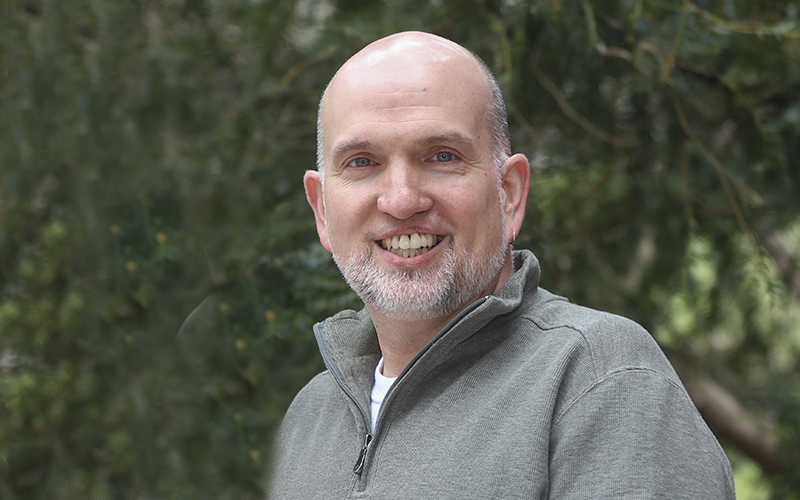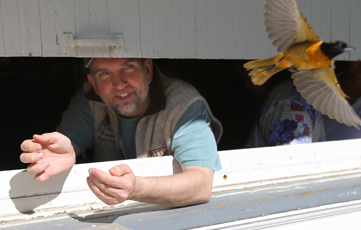
Mark Deutschlander

Mark E DeutschlanderProfessor of Biology
Joined faculty in 2002
1998 Ph.D., Indiana University
1992 B.S. summa cum laude, SUNY Geneseo
Contact Information
Scholarly Interest
Animal orientation and navigation, particular the use of magnetic and celestial cues by migratory birds.
Ecophysiology of migration, particular the energetic needs and constraints of migratory birds.
Ultraviolet and polarized light photoreception in vertebrates and insects.
Teaching Experience
2015-present Full Professor of Biology, Hobart and William Smith Colleges
2009-2012 Chair of Biology, Hobart and William Smith Colleges
2008-2011 Chair of Health Professions Program, Hobart and William Smith Colleges
2008-2015 Associate Professor of Biology, Hobart and William Smith Colleges
2002-2008 Assistant Professor of Biology, Hobart and William Smith Colleges
2000-2002 Assistant Professor of Biology. Rochester Institute of Technology, Rochester, NY.
1999-2000 Postdoctoral Fellow in Biology. University of Victoria, Victoria, B.C., Canada.
1998 Visiting Scholar. University of Technology at Sydney, Australia.
Courses Taught
Topics in Introductory Biology – Animal Minds
General Physiology
Neurobiology
Bird Obsessions First-Year Seminar
Biology Senior Seminar on Migration and Animal Navigation
Publications
Holzschuh, J.A. and M.E. Deutschlander. 2016. Do migratory warblers carry excess fuel reserves during migration for insurance or for breeding purposes? The Auk: Ornithological Advances 133: 459-469.
Deutschlander, M.E. and R.C. Beason. 2014. Avian navigation and geomagnetic positioning. Journal of Field Ornithology. 85:111-133.
Muheim, R., I. Henshaw, S. Sjöberg, and M.E. Deutschlander. 2014. BirdOriTrack: a video tracking program as new tool in experimental orientation research with migratory birds. Journal of Field Ornithology 85:91-105.
Fail, J., M.E. Deutschlander, and A.M. Shelton. 2013. Antixenotic resistance of cabbage to onion thrips (Thysanotera: Thripidae) I. Light Reflectance. Journal of Economic Entomology106:2602-2612.
Deutschlander, M.E., J.B. Phillips, and U. Munro. 2012. Age-dependent orientation to magnetically-simulated geographical displacements in migratory Australian Silvereyes (Zosterops l. lateralis). The Wilson Journal of Ornithology 124(3): 467-477.
Diaz-Montano, J., J. Fail, M.E., Deutschlander, B.A., Nault, and A.M. Shelton. 2012. Characterization of resistance, evaluation of the attractiveness of plant odors and effect of leaf color on different onion cultivars to onion thrips (Thysanoptera: Thripidae). Journal of Economic Entomology. 105(2): 632-641.
Deutschlander, M.E. and R. Muheim. 2010. Magnetic Orientation in Migratory Songbirds. In. M.D. Breed and J. Moore, Editor(s)-in-Chief, Encyclopedia of Animal Behavior, Academic Press, Oxford, pp. 314-323. ISBN 978-0-08-045337-8.
Muheim, R., J.B. Phillips, and M.E. Deutschlander. 2009. White-throated sparrows calibrate their magnetic compass by polarized light cues during both autumn and spring migration. Journal of Experimental Biology 212: 3466-3472.
Deutschlander, M.E. and R. Muheim. 2009. Fuel reserves affect migratory orientation of thrushes and sparrows both before and after crossing an ecological barrier near their breeding grounds. Journal of Avian Biology 40: 85-89.
Feller, K.D., S. Langerholm, R. Clubwala*, M.T. Silver, D. Haughey, J.M. Ryan, E.R. Loew, M.E. Deutschlander, and K.L. Kenyon. 2009. Characterization of photoreceptor cell types in the little brown bat Myotis lucifugus. Comparative Biochemistry & Physiology 154: 412-418.
PROFESSIONAL AFFILIATIONS
President for the Wilson Ornithological Society
Associate Editor for The Auk: Ornithological Advances
Certified Bird Banding Trainer, North American Bird Banding Council
Board Member and scientific advisor (and Past President and Vice President) for the Board of Directors for the Braddock Bay Bird Observatory since 2000. Bird Observatory (www.bbbo.org) is a non-profit organization dedicated to ornithological research, education and conservation. Our primary mission is to monitor migration of songbirds during fall and spring migration on the south shore of Lake Ontario near Braddock Bay (near Rochester, NY).
PERSONAL STATEMENT
For many years I defined myself as a sensory ecologist driven by a curiosity about the ways animals sense the world and how they use sensory information for daily tasks and behavior. One particular behavior that has always fascinated me is migration. Mass movements of animals, some of which occur during the night while most of us are fast asleep, astound me. How organisms find their way, and the senses they use to navigate, during these movements has been, and still is, the focus of much of my research. However, now in the middle of my scholarly career, my interests have broadened and my research program has grown from one solely attentive to the sensory biology of orientation to one motivated by a desire to more fully understand the migratory biology of one group of organisms - songbirds. Perhaps the most recognized example of migration, bird migration hardly goes unnoticed by anyone who takes note of the natural world, and it is the topic of many popular books, newspaper and magazine articles, and documentary and popular films. However, what we still don’t know about this well-known phenomenon will likely fill numerous pages of journals and textbooks in the future.
- How do songbirds (and other animals) know when to migrate, where to go, and how to get there?
- How do songbirds meet the environmental and physiological challenges of migration? How does migratory ecology associated with these movements shape the patterns of songbirds we observe in space and time?
These are all questions for which science has at least, but only, partial answers, and it is the first of these series of questions that marked the research of much of my career. An examination of publications from my Ph.D. work at Indiana University and my post-doctoral position at University of Victoria demonstrate a focus on sensory biology, and an attempt to understand the sensory systems that underlie migratory and spatial behaviors of animals such as salamanders, rodents, and fish. My curiosity then, and still now, has steered me towards research on sensory “windows” that humans do not possess, particular a sense of the earth’s magnetic field and the visual sense(s) for ultraviolet and polarized light. Our knowledge that animals can sense these geophysical features and use these sensory cues for orientation is still relatively recent; for example, the first demonstration of a magnetic compass sense in any birds was published in the mid-1960s! Yet, scientists have yet to fully or adequately describe the sensory systems, or even the sensory receptor cells, used by animals for magnetoreception. Nor do we fully comprehend how animals, like songbirds, use geomagnetic information for both compass information (a sense of direction) and map information (a sense of position), or how they combine magnetic information with other cues, such as celestial information (e.g., spectral and/or polarized light patterns in the sky, star patterns, sunset, etc.). While I have conducted and published research on all these questions about orientation and navigation, my focus at Hobart & William Smith Colleges (HWS) has been on how birds use and combine these cues for orientation and navigation (e.g., Muheim, Phillips, & Deutschlander 2009, Deutschlander, Munro, & Phillips 2014).
Avian orientation and navigation has been studied largely by European ornithologists working on Old World (Eastern Hemisphere) species. Only a few species have been studied in the Western Hemisphere, and we do know that species and populations can vary in how they use orientation cues. Our understanding, therefore, of the use of orientation cues by migrants that traverse the Americas is limited, and there is a need to learn more about these species for conservation (see Deutschlander & Beason 2014). Several of my recent publications have been in North American ornithological journals (e.g. Wilson Journal of Ornithology, Journal of Field Ornithology). I have purposely chosen these journals (rather than journals of other biological disciplines, such as Animal Behavior, or journals from other ornithological countries, such as Ibis) and written reviews and methodological papers (i.e. Deutschlander & Muheim 2010, Deutschlander & Beason 2014, Muheim, Henshaw, Sjöberg, & Deutschlander 2014), to try to stimulate more research on orientation by ornithologists working on migratory species in the Western Hemisphere.
The majority of my research is conducted at the Braddock Bay Bird Observatory (BBBO), which is located on the south shore of Lake Ontario. I first began my relationship with the Observatory by asking whether I could establish a laboratory on their property for orientation experiments. I soon, however, became fully involved in many of BBBO’s activities focused on migration monitoring of songbirds. Banding migratory birds during fall and spring allowed me to learn much more about their migratory biology than provided by my previous training as a sensory biologist. I had many new questions about these amazing migratory movements, and I expanded my research program to understand the physiological, or energetic challenges, of migration in songbirds. The energy requirements and constraints of these avian athletes are phenomenal, and the energetic condition of individuals even shapes their orientation choices. My research now includes both (1) examining the influence of energetic condition on orientation (i.e. Deutschlander & Muheim 2009, Holzschuh & Deutschlander - submitted to WJO) and (2) comparing patterns of energetic condition in migratory songbirds both within and between species to learn more about overall migration and stopover ecology (e.g., Holzschuh & Deutschlander - submitted to Auk). I have spent significant time and resources building an orientation laboratory at BBBO and I use data collected from migration monitoring at BBBO in my research and publications. I also use other publically available data, such as recapture data on banded birds from the U.S.G.S. Bird Banding Laboratory (BBL), to help learn more about migratory movements (e.g. Taylor, Eldredge, & Deutschlander – in preparation).
While the majority of my scholarly activities have focused on songbird migration, my training and interest in vision and visual ecology have resulted in two fruitful collaborations on other organisms over the last several years. I contributed to and co-authored a paper on bat vision with fellow HWS faculty and students (Feller et al. 2009). In addition, in collaboration with researchers at the New York State Agricultural Experiment Station, I conducted research on insect (i.e. thrips) agroecology that resulted in two publications (Fail, Deutschlander, & Shelton 2013, Diaz-Montano, Fail, Deutschlander, Nault, & Shelton 2012). 
